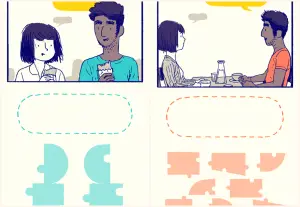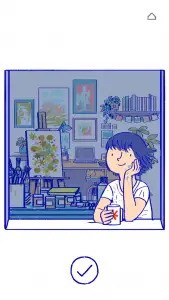If you’re a fan of literature and video games, you may have found yourself coming to the defense of games as a vehicle for storytelling, arguing that some do have literary merit. A lot of games, after all, do tell stories. Usually, these stories are used to draw players in and keep them coming back in order to complete the story arc.
For the app and game, “Florence,” story combines with beautiful sound and visuals to create a literary journey right on your phone. Even though it only takes about 40 minutes or less to complete the whole game, the beauty of it will have you coming back for more.
*Consider purchasing “Florence” for $2.99 and playing before finishing this article if you want a completely spoiler-free experience.
When you open the app, now available on iOS and more recently Android, you are met with some gentle piano music and the face of the game’s main character. Get used to the adorable art style and fitting, striking music, because it permeates the entire game.
Once you begin, the game introduces you to Florence Yeoh. In meeting Florence, you become her. You start with her morning, hitting the snooze button, brushing her teeth and commuting to work. Constantly engaging with her life throughout her day brings you even closer to her as you follow her on the journey of her first love and heartbreak with character Krish.
Instead of just passively reading, the story allows you to actively participate by scrolling and clicking your way through Florence’s life. Some scenes are set up more like a comic with panels while others fill the screen as you click through. The app is more than a visual novel, though, as small mini-game mechanics appear throughout the story, making the app a game as well.
But the game is undoubtedly a story. Structured in acts with chapters, Florence’s life and the game itself present like a traditional novel or play would be. These parts are one small aspect that gives the game its literary quality despite the lack of words.
It may not even seem like “Florence” has a story considering the conversations don’t contain actual dialogue. But musical cues, black and white images versus bright, colorful ones and characters’ facial expressions let you decide what they’re saying to each other.
Active involvement only serves to draw you more into the story and makes your investments in the characters that much stronger, all while understanding the emotional core of the story. Not only do you create aspects of the story in your head, but you help the story progress through the various mini-game mechanics that pop up.
One of the most symbolic and gorgeous mechanics in “Florence” is a puzzle used to complete conversation bubbles. In the beginning of Krish and Florence’s relationship, there are several puzzle pieces to assemble in their conversations.
As the relationship develops, the pieces get bigger and there are less to slide into place. Eventually, the conversations aren’t puzzles at all, just one bubble you slide into place, perfectly capturing the development of comfort with someone over time.

Mechanics like these don’t only show up once, though. “Florence” does a great job of bringing back mechanics to make heart-wrenching callbacks. When Krish moves in, you decide what you place in Florence’s apartment while putting other items in storage.
Later on, the mechanic comes back, but not for as happy a reason. When Krish moves out, players will go through the conflicting ordeal of remembering which items are his. Heartbreak aside, another charming part of the story is the fact that it doesn’t only focus on Florence’s love life.

You see her dream of being an artist and watch her work toward it until her dream comes true. You see her personal growth and how she builds a better relationship with her mom. All of that comes after the heartbreak, effectively putting a bandage on any broken hearts and drying any tears that the sadder parts of the game may have caused. You may not even mind the heartache, though, because of all of the exquisiteness the game has to offer.
Reviews from critics and fans alike paint “Florence” as a stunning game, from visuals to mechanics and more. A reviewer on iTunes praises, “The graphics and the incredibly thought-out ways of capturing a relationship without using any dialogue are two of the best strengths of this game/exploration into a character’s life and love.”
The reviewer goes on, “However, the one criticism I have for the game is that I wish it was longer. I played the entire game within 25-ish minutes and man, did I wish for more. But perhaps this isn’t even a criticism, because it was so well-done that I was the one left wanting.”

While the time you spend playing “Florence” will range based on how slowly you take the journey, you’re likely to witness the well-thought-out ways the game presents its story. You may want to avoid playing the game in public if you’re prone to tears, but no matter where you choose to play it, it’s totally worth the purchase and experience.
So if you’re looking for something else to add to the games-with-literary-merit pile, “Florence” is for you.

















